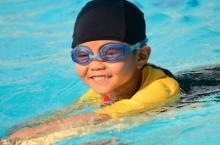
Whether trying to cool off in warm weather or competing in a sporting event, swimming is enjoyed by children and adults alike and is listed as the second most popular sports activity in the United States. Swimming is great exercise, offers physical and mental health benefits, and is fun for the whole family.1
Early evidences of swimming activities are depicted in drawings on Egyptian artifacts as early as 4000 BC, and the Bible and the Greek poems, “The Iliad” and “The Odyssey,” refer to swimming in their writings.2 Although swimming was not part of the early Olympics, the Greeks held swimming as an important activity, and Plato promoted swimming as an essential part of a proper education. The early Romans also extolled the benefits of swimming as did the Egyptians, the Phoenicians, and the Persians.
The Japanese held swimming competitions as early as 1603, when the emperor decreed that schoolchildren should compete in swimming races. The British were the early proponents of swimming as a competitive sport in the early 1800s, which spread throughout Europe. By 1837, it is recorded that London had six indoor swimming pools where swimming contests took place.3
Organized swimming clubs and associations were formed in the 1800s and 1900s with increased interest in competitive swimming events between groups. The first swimming events were introduced to the modern Olympics in 1896 in Athens. Swim clubs, recreation centers, YMCAs, and schools and universities developed programs that included swimming pools and lessons to further the recreation and sport of swimming during the 20th century.4
While playing in water can be enjoyed by most everyone, learning to swim properly usually requires swimming lessons given by an accomplished swimmer. Swimming classes are often available by certified Red Cross instructors at a recreation center or YMCA. Learning the proper techniques of swimming is more important than strength or endurance and they must be mastered to become efficient at swimming.
There are three elements to swimming that need to be mastered: kicking, breathing, and stroking. Children are usually first taught to flutter kick their legs by holding on to the side of the pool and stretching their bodies out behind them. Blowing bubbles while kicking and holding the side of the pool help them grasp the concept of the form of their bodies as they rotate from side to side to lift their faces out of the water. Adding the arm movements with particular swimming strokes is the last component to complete the technique. Practice and good form produce endurance.5 Children often use flotation devices, such as kickboards or noodles, to help them keep afloat as they learn their basic techniques. These flotation devices can help them overcome fatigue and build their confidence in the water.6
There are five basic swimming strokes:
- Dog Paddle – One of the first strokes learned by children, the dog paddle consists of moving the hands and legs in short, quick strokes with the head above water, much like a dog swims.
- Front Crawl – Also called the freestyle stroke in competitions, the swimmer uses large alternating windmill strokes with the arms and kicks with fully extended legs while lying face down in the water.
- Backstroke – Similar to the front crawl, the swimmer lies on his back and uses windmill strokes with his arms and kicks with his legs.
- Breaststroke – A more difficult and exhausting stroke, the breaststroke requires both arms to be fully extended in front of the body and then pulled back to the chest. The swimmer’s body dips below the water and then is propelled forward with the arms, hands, and legs.
- Butterfly – Probably the most difficult stroke to master, the butterfly employs a dolphin-like motion of the body used to propel the swimmer forward as the arms are extended in a T formation and then brought in like diving into the water.7
There are many wonderful benefits of swimming for all children. Swimming involves all the systems in the body and aids in cardiovascular and pulmonary function, increases and tones muscle mass, and is a great stress reliever. The low-impact nature of swimming in water benefits children with physical difficulties and can aid in the stretching and movement of the affected limbs. Children with autism spectrum disorder can be calmed by the soothing environment the gentle pressure of water on their bodies gives them. Swimming fast can also help some children work out feelings of frustration and anger by elevating their moods with naturally produced endorphins boosted by physical exercise.8
Besides enjoying swimming pools, children can also swim in lakes, ponds, streams, and oceans. Protective footwear is advisable for surfaces that may be rough or rocky, and trash and broken bottles could be hidden from view. Ocean waves might knock children down, and strong rip tides can carry even strong swimmers away from shore. It is always advisable to swim with a buddy and have a lifeguard on duty.9
- 1. “Health Benefits of Water-Based Exercise.” Centers for Disease Control and Prevention. < http://www.cdc.gov/healthywater/swimming/health_benefits_water_exercise.html > 9 Feb. 2012.
- 2. Weil, Richard. “Swimming.” MedicineNet.com. < http://www.medicinenet.com/swimming/article.htm > 9 Feb. 2012.
- 3. Barlowe, Barrett. “Origins of Swimming.” Livestrong.com. < http://www.livestrong.com/article/345577-origins-of-swimming/ > 9 Feb. 2012.
- 4. Op. cit., Weil.
- 5. Sloan, Jim. “How To Learn Basic Swimming.” Livestrong.com. < http://www.livestrong.com/article/96328-learn-basic-swimming/ > 9 Feb. 2012.
- 6. Op. cit., Weil.
- 7. Patterson, James. “What Are The Five Basic Swim Strokes?” Livestrong.com. < http://www.livestrong.com/article/103712-five-basic-swim-strokes/ > 9 Feb. 2012.
- 8. Barlowe, Barrett. “Benefits Of Swimming For Children With Learning Difficulties.” Livestrong.com. < http://www.livestrong.com/article/209131-benefits-of-swimming-for-children-with-learning-difficulties/ > 9 Feb. 2012.
- 9. “Swimming.” KidsHealth.org. < http://kidshealth.org/kid/watch/out/swim.html > 9 Feb. 2012.

